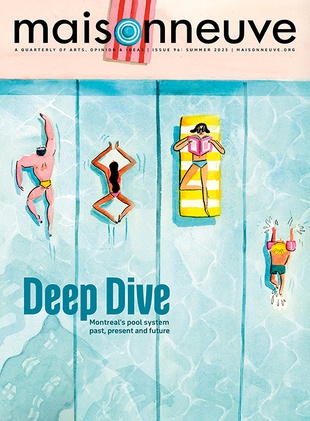Charge of the Ice Brigade
Snicker Department
The sport of figure skating was born in Dark Age Holland. Cocoa farmers, rebuilding their dikes in winter when the frozen Danube could not wash away their work, hired speed skaters to carry sacks of gravel from estuarial quarries. Punters on the towpaths would then guess how many pounds (heavier than ours and still called “stones” in Europe) Roeloff or Ernst was carrying on his back. And so the game became known as feggerskaten (from fegger, Old Dutch for “wager”).
As it raged through Europe, like the Bible a generation before it, the young sport gained through innovation wherever it lost in translation. The Italians, for instance—who let the sea flood their cities instead of building dikes—quickly dropped the Dutch rock-sacks in favour of diminutive socialites. Big Lotharios would lift little ladies onto their shoulders and race from the Leaning Tower to St. Mark’s.
Italian skaters had already begun tracing primitive figaros in the ice. However, it was not until 1394, when the Venetian Skating Festivalati took on the Ottoman Ice Brigade, that the blade-sketching familiar to us today was introduced to the sport. Scandalized Italian courtiers decried the Ottomans’ figures as “crazy Arabic scribbles”; enraged Ottoman dignitaries condemned the home team’s “primitive Roman sticks.” After the furs stopped flying, the Italians lay trounced. The triumphant Eastern curvilinearists packed up their gifts of tobacco and sequins, as well as Dante’s ill-fated ice dancers Marco and Polo, and launched a thrilling tour of the continent.
The Ottoman Ice Brigade’s legendary tour sparked a period of rapid growth, with one technical breakthrough after another. During the tour’s stop in Leipzig, Karida Azziznikoff, as Princess Jasmine, performed the first spin in official competition: hopping out of a 6, screwing a decimal, hopping again and carving a perfect 0. She would have taken the gold had the Anglo-Saxon judge (as part of an intricate diplomatic escapade that saw Bohemia go to Poland, the marauding hordes to Rumelia and the World Cudgelling Championships to Birmingham) not whacked her in the kiss and cry after her short program.
In the New World, Professor Todd Koenig (Lutz Find Out About Ice Skating!, Harvard University Press, 1963) traces the sport’s literary debut to Hospitality Madison’s Winter Observances and Diversions. The popular hostess records the visit to a trading post in Lower Canada of a certain “Rayer Laydee of Frants,” whose performance at an ice gala Mrs. Madison translated for the media as “Vayery Fantsy.”
“Fancy” skating, as it was then known, swept the colonies. Within a few years, common sense and republican spirit had overthrown the Byzantine judging regime. “Guess the figure!” became “How do you fancy that?” Skaters embraced the reforms, save a small troupe of purists who fled unpursued to Winnipeg.
Change did not come easily to the Old World. For two centuries, Atlantic Rim competitions were battles of dressing-room diplomacy, beverage tariffs and colourful ethnic slang. Brawls regularly spilled out of the jury box onto the ice. Finally, in 1898, at the Lisbon Winter Carnival, President Roosevelt broke a deadlock in the men’s event by lobbing a teddy bear at the Queen of Sweden. The response was immediate. European skaters, as a body, threw off their skate guards and appealed to the crowd: “Why should the judges get the plush toys?” The twentieth century had begun.
Over the next eighty years, North American skaters bobbed their hair, shortened their skirts, positioned livestock on frozen ponds and performed great ankle-strengthening leaps: pluck-the-hen, geld-the-pony and the double sow-cow. Across the ocean, athletes fused the graceful leaps, reeling lifts and distressed leotards of ballet with the agonized face-painting, torrid hair and flying camels of opera—synthesizing the two grand art forms into the potent style that, accompanied by British New Wave pop music, invaded North American rinks in the 1980s.
Today, it is fitting the “fancy” sport should be called figure skating, for the computational feats judges perform are a gruelling biathlon of mind and spirit. Consider: when the young man stops in the middle of his “Rapture of Napoleon,” cocks a hip, spanks it, salutes, winks and makes fish-lips, he is asking, How do I tickle your fancy? The judges must answer with a number. When a daring Lancelot lifts, upends and twizzles his Guinevere, etching a flawless 69 in the ice, the judges must also factor that figure into their tallies.
Like the epic struggle of Classical and Romantic, the ancient rivalry of Figure and Fancy will surely accompany this sport into its second fantastic millennium. We watch, as ever: furious, ecstatic, alive.





